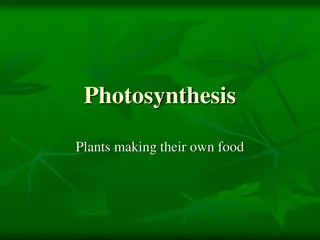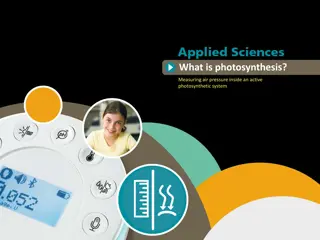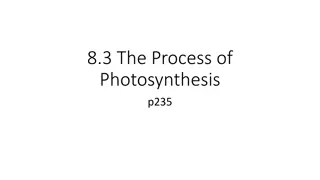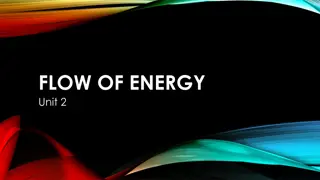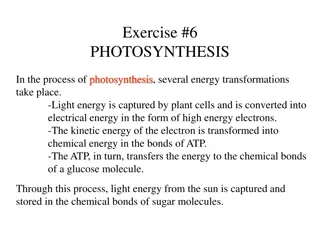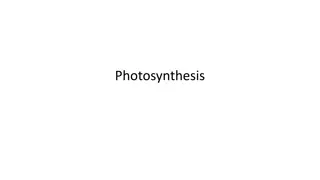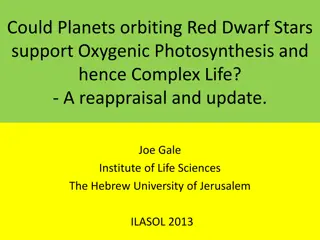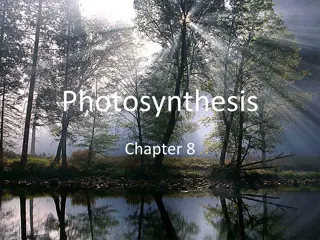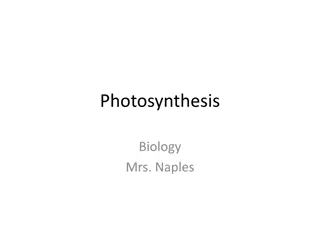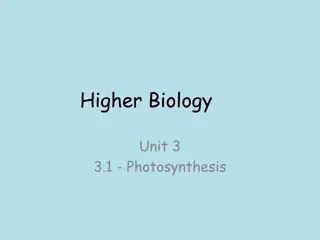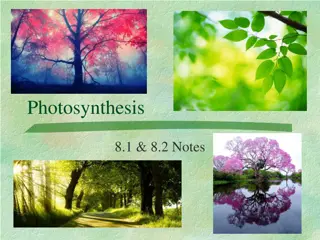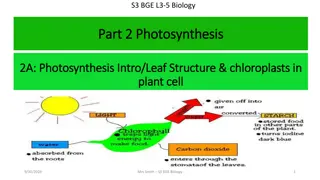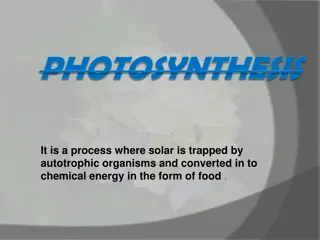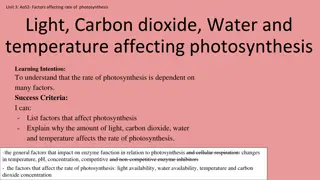Understanding Bacterial Photosynthesis: Types and Processes
Photosynthesis is the conversion of light energy into chemical energy, crucial for growth and production of ATP. Prokaryotes such as cyanobacteria, purple and green bacteria, and halobacteria demonstrate different forms of photosynthesis. Oxygenic photosynthesis, found in cyanobacteria, releases oxygen as a byproduct. Additionally, various bacterial groups conduct anoxygenic photosynthesis, utilizing different pigments and pathways for energy production. This process involves intricate mechanisms such as light reactions and dark reactions to convert light energy into ATP and carbohydrates. Detailed insights into the types of bacterial photosynthesis and photosynthetic pigments are also discussed.
- Bacterial Photosynthesis
- Cyanobacteria
- Anoxygenic Photosynthesis
- Light Reactions
- Photosynthetic Pigments
Download Presentation

Please find below an Image/Link to download the presentation.
The content on the website is provided AS IS for your information and personal use only. It may not be sold, licensed, or shared on other websites without obtaining consent from the author. Download presentation by click this link. If you encounter any issues during the download, it is possible that the publisher has removed the file from their server.
E N D
Presentation Transcript
Photosynthesis is the use of light as a source of energy for growth, more specifically the conversion of light energy into chemical energy in the form of ATP. Prokaryotes that can convert light energy into chemical energy include the photosynthetic cyanobacteria, the purple and green bacteria, and the "halobacteria" (actually archaea). The cyanobacteria conduct plant photosynthesis, called oxygenic photosynthesis The purple and green bacteria conduct bacterial photosynthesis or anoxygenic photosynthesis The extreme halophilic archaea use a type of nonphotosynthetic photophosphorylation mediated by a pigment, bacteriorhodopsin, to transform light energy into ATP. Net equation: 6CO 2 +12H2O+LightEnergy C6H12O6+6O2+6H20 Photosynthetic reactions divided into two stages: Light reaction - light energy absorbed & converted to chemical energy (ATP, NADPH) Dark reaction- carbohydrates made from CO2 using energy stored in ATP & NADPH
Types of bacterial photosynthesis Five photosynthetic groups within domain Bacteria (based on 16S rRNA): 1. Oxygenic Photosynthesis Occurs in Cyanobacteria and prochlorophytes Synthesis of carbohydrates results in release of molecular O2 and removal of CO2 from atmoshphere. Occurs in lamellae which house thylakoids containing chlorophyll a/b and phycobilisomes pigments which gather light energy Uses two photosystems (PS): - PS II- generates a proton-motive force for making ATP. - PS I- generates low potential electrons for reducing power.
The oxygenic photosynthetic bacteria are unicellular or multicellular and possess bacteriochlorophyll a and carry out oxygenic photosynthesis. They contain phycobilins. One group, prochlorophytes lack phycobilins, but contain both bacteriochlorophyll a and b. They are mostly represented by Gram-negative cyanobacteria having only membrane. The light harvesting pigments are phycobilin proteins, phycoerythrin, phycocyanin, bacteriochlorophyll a and carotenoids but sheath capsule may contain yellow pigment called scytonemin or red-blue pigment gloeocapsin which may mask cellular pigmentation. Phycobilins form phyobilisomes on both surfaces of membrane called thylakoids. Bacteriochlorophyll a and carotenoids are part of it.
2. Anoxygenic Photosynthesis Uses light energy to create organic compounds, sulfur or fumarate compounds instead of O2. Occurs in purple bacteria, green sulfur bacteria, green gliding bacteria and heliobacteria. Uses bacteriochlorophyll pigments instead of chlorophyll. Uses one photosystem (PS I) to generate ATP in cyclic manner. Ammonium salts are generally used as nitrogen source. Nitrogen fixation has been reported in some bacterial species. Some can grow chemo-auto-trophically under aerobic/micro-aerobic condition. Fatty acids, ethanol and organic acids serve as carbon sources. They are found in fresh water, brackish water, and marine and hyper-saline water
Photosynthetic Pigments There are several types of pigments distributed among various phototrophic organisms. Chlorophyll is the primary light-harvesting pigment in all photosynthetic organisms. Chlorophyll is a tetrapyrrole which contains magnesium at the center of the porphyrin ring. It contains a long hydrophobic side chain that associates with the photosynthetic membrane. Cyanobacteria have chlorophyll a, the same as plants and algae. The chlorophylls of the purple and green bacteria, called bacteriochlorophylls are chemically different than chlorophyll a in their substituent side chains. This is reflected in their light absorption spectra. Chlorophyll a absorbs light in two regions of the spectrum, one around 450nm and the other between 650 -750nm Bacterial chlorophylls absorb from 800-1000nm in the far red region of the spectrum.
Carotenoids are always associated with the photosynthetic apparatus. They function as secondary light-harvesting pigments , absorbing light in the blue-green spectral region between 400-550 nm. Carotenoids transfer energy to chlorophyll, at near 100 percent efficiency, from wave lengths of light that are missed by chlorophyll. In addition, carotenoids have an indispensable function to protect the photosynthetic apparatus from photo oxidative damage. Carotenoids have long hydrocarbon side chains in a conjugated double bond system. Carotenoids "quench" the powerful oxygen radical, singlet oxygen, which is invariably produced in reactions between chlorophyll and O2 (molecular oxygen). Some non-photosynthetic bacterial pathogens, i.e., Staphylococcus aureus, produce carotenoids that protect the cells from lethal oxidations by singlet oxygen in phagocytes.
Phycobiliproteins are the major light harvesting pigments of the Cyanobacteria and may also occur in some groups of algae. They may be red or blue, absorbing light in the middle of the spectrum between 550 and 650nm. Phycobiliproteins consist of proteins that contain covalently-bound linear tetrapyrroles (phycobilins). They are contained in granules called phycobilisomes that are closely associated with the photosynthetic apparatus. Being closely linked to chlorophyll they can efficiently transfer light energy to chlorophyll at the reaction center.
Light Reaction The Light Reactions depend upon the presence of chlorophyll, the primary light-harvesting pigment in the membrane of photosynthetic organisms. The functional components of the photochemical system are light harvesting pigments, a membrane electron transport system, and an ATPase enzyme. The photosynthetic electron transport system of is fundamentally similar to a respiratory ETS, except that there is a low redox electron acceptor (e.g. ferredoxin ) at the top (low redox end) of the electron transport chain, that is first reduced by the electron displaced from chlorophyll. All phototrophic bacteria are capable of performing cyclic photophosphorylation. The universal mechanism of cyclic photophosphorylation is referred to as Photosystem I. Bacterial photosynthesis uses only Photosystem I (PSI), but the more evolved cyanobacteria, as well as algae and plants, have an additional light-harvesting system called Photosystem II (PSII). Photosystem II is used to reduce Photosystem I when electrons are withdrawn from PSI for CO2 fixation. PSII transfers electrons from H2O and produces O2.
(i) Cyclic photosynthetic electron transport: Excitation of P-840 in pigment system by a photon of light results in transfer of an electron from the reaction centre to Cyt be1 complex through a quinone (Q) and back to the reaction centre via Cyt C553. The electron transport through the Cyt bc1 complex causes proton pumping across the membrane, producing a proton motive force that powers synthesis of ATP from ADP + Pi by ATP synthase (photophosphorylation). (ii) Non-cyclic photosynthetic electron transport: During this process, some electrons flow from excited P-840 to an Fe-S protein Ferredoxin (Fd), which in turn passes electrons to NAD+ through Fd: NAD- reductase and ultimately forming NADH. The electrons from the reaction centre which reduce NAD+ NADH, are compensated by electrons coming from oxidation of H2S to elemental S and then to SO42-. This process is chemically analogous to oxidation of H2O by oxygenic plants.
Dark reaction The use of RUBP carboxylase and the Calvin cycle is the most common mechanism for CO2 fixation among autotrophs. Indeed, RUBP carboxylase is said to be the most abundant enzyme on the planet (nitrogenase, which fixes N2 is second most abundant). This is the only mechanism of autotrophic CO2 fixation among eukaryotes, and it is used, as well, by all cyanobacteria and purple bacteria. Lithoautotrophic bacteria also use this pathway. But the green bacteria and the methanogens, as well as a few isolated groups of prokaryotes, have alternative mechanisms of autotrophic CO2 fixation and do not possess RUBP carboxylase. RUBP carboxylase ( ribulose bisphosphate carboxylase ) uses ribulose bisphosphate (RUBP) and CO2 as co-substrates. In a complicated reaction the CO2 is "fixed" by addition to the RUBP, which is immediately cleaved into two molecules of 3-phosphoglyceric acid (PGA). The fixed CO2 winds up in the -COO group of one of the PGA molecules. Actually, this is the reaction which initiates the Calvin cycle.
The Calvin cycle is concerned with the conversion of PGA to intermediates in glycolysis that can be used for biosynthesis, and with the regeneration of RUBP, the substrate that drives the cycle. After the initial fixation of CO2, 2 PGA are reduced and combined to form hexose-phosphate by reactions which are essentially the reverse of the oxidative Embden-Meyerhof pathway. The hexose phosphate is converted to pentose-phosphate, which is phosphorylated to regenerate RUBP. An important function of the Calvin cycle is to provide the organic precursors for the biosynthesis of cell material. Intermediates must be constantly withdrawn from the Calvin cycle in order to make cell material. In this regard, the Calvin cycle is an anabolic pathway. The fixation of CO2 to the level of glucose (C6H12O6) requires 18 ATP and 12 NADPH2.
Reductive Carboxylic Acid Cycle: In some photosynthetic bacteria such as Chlorobium, Chromatium etc. another carbon reduction cycle is known to operate which is called as Reductive Carboxylic Acid Cycle.
Reduced ferredoxin generated during photochemical process has strong reducing potential which drives the reversal of two reactions of Krebs Cycle which are otherwise irreversible in aerobic cell. Acetyl-CoA + CO2 + Fd (Red) Pyruvate + CoA + Fd (oxi) Succinyl-CoA + CO2 + Fd (Red) -ketoglu tarate + CoA + Fd (oxi) Each turn of this cycle incorporates 4CO2 molecules which results in net synthesis of one oxaloacetate molecule. Oxaloacetate by further metabolism through this cycle provides C2 C6 carbon compounds which are utilised for the synthesis of various amino acids, lipids and other organic compounds in bacterial cells. However, the amino acids are main soluble products of photosynthesis in such bacteria. -keto acids such as pyruvate, oxaloacetate and -ketoglutarate produced during this cycle after amination may result in the formation of amino acids-alanine, aspartate and glutamate respectively. Reductive carboxylic acid cycle does not occur in algae and higher green plants.
Carbon Assimilation in Bacteria Using Organic Compounds: Certain purple bacteria make use of simple organic compounds such as acetic acid, butyric acid, propionic acid etc. as the major carbon source for photosynthesizing organic matter in the cells. In such cases, photo assimilation of organic compounds usually directly leads to the formation of organic polymers. For instance, in Rhodospirillum rubrum conversion of acetic acid into poly- - hydroxybutyric acid is a reductive process:- 2nC2H4O2+ 2nH (C4H6O2)n + 2nH2O Similarly, photo assimilation of succinic acid, propionic acid etc. leads to the accumulation of glycogen like polysaccharides. Photosynthesis of these carbon reserves inside the bacterial cells appears to be analogous to the formation of starch in algae and higher green plants.






